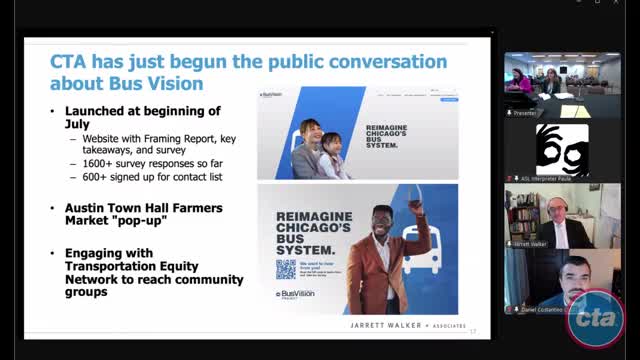CTA launches ambitious plan to transform bus service
September 11, 2024 | Chicago Transit Authority Board, C, Boards and Commissions, Executive, Illinois
This article was created by AI summarizing key points discussed. AI makes mistakes, so for full details and context, please refer to the video of the full meeting. Please report any errors so we can fix them. Report an error »

In a recent government meeting, officials discussed the critical \"Better Streets for Buses\" initiative, which aims to enhance bus service through improved street infrastructure. This plan is designed to work in conjunction with the \"Bus Vision\" project, focusing on both network design and the physical environment that supports bus transit. The discussions emphasized the importance of public engagement, with surveys and community events already underway to gather input on service priorities, including ridership equity and bus stop spacing.
Officials highlighted the need for a dual approach: while long-term strategies are being developed, immediate actions are being taken to address current bus service challenges. This includes identifying key areas for infrastructure investment to expedite bus travel and extending existing routes, such as the Ashland Avenue route.
Concerns were raised about the historical context of funding inequities affecting the Chicago Transit Authority (CTA), particularly how past policies have led to diminished service levels, especially in low-income and minority communities. The meeting underscored the necessity of addressing these systemic issues to restore and enhance service equity.
Directors also discussed the importance of presenting these findings to state legislators to secure necessary funding. They noted that a clear articulation of the historical injustices and current service disparities could help garner support for the CTA's funding requests. The meeting concluded with a commitment to continue community outreach and refine service standards based on public feedback, aiming for a comprehensive bus vision proposal by late 2025.
Officials highlighted the need for a dual approach: while long-term strategies are being developed, immediate actions are being taken to address current bus service challenges. This includes identifying key areas for infrastructure investment to expedite bus travel and extending existing routes, such as the Ashland Avenue route.
Concerns were raised about the historical context of funding inequities affecting the Chicago Transit Authority (CTA), particularly how past policies have led to diminished service levels, especially in low-income and minority communities. The meeting underscored the necessity of addressing these systemic issues to restore and enhance service equity.
Directors also discussed the importance of presenting these findings to state legislators to secure necessary funding. They noted that a clear articulation of the historical injustices and current service disparities could help garner support for the CTA's funding requests. The meeting concluded with a commitment to continue community outreach and refine service standards based on public feedback, aiming for a comprehensive bus vision proposal by late 2025.
View full meeting
This article is based on a recent meeting—watch the full video and explore the complete transcript for deeper insights into the discussion.
View full meeting
